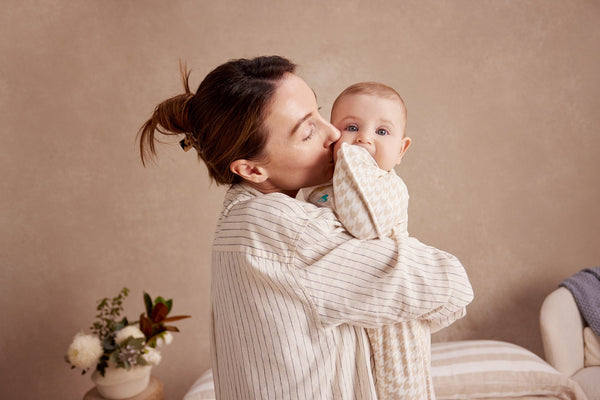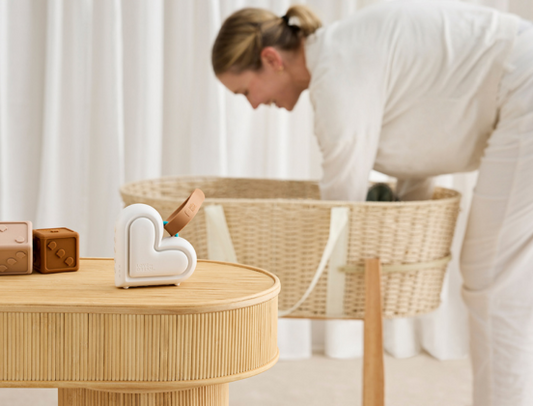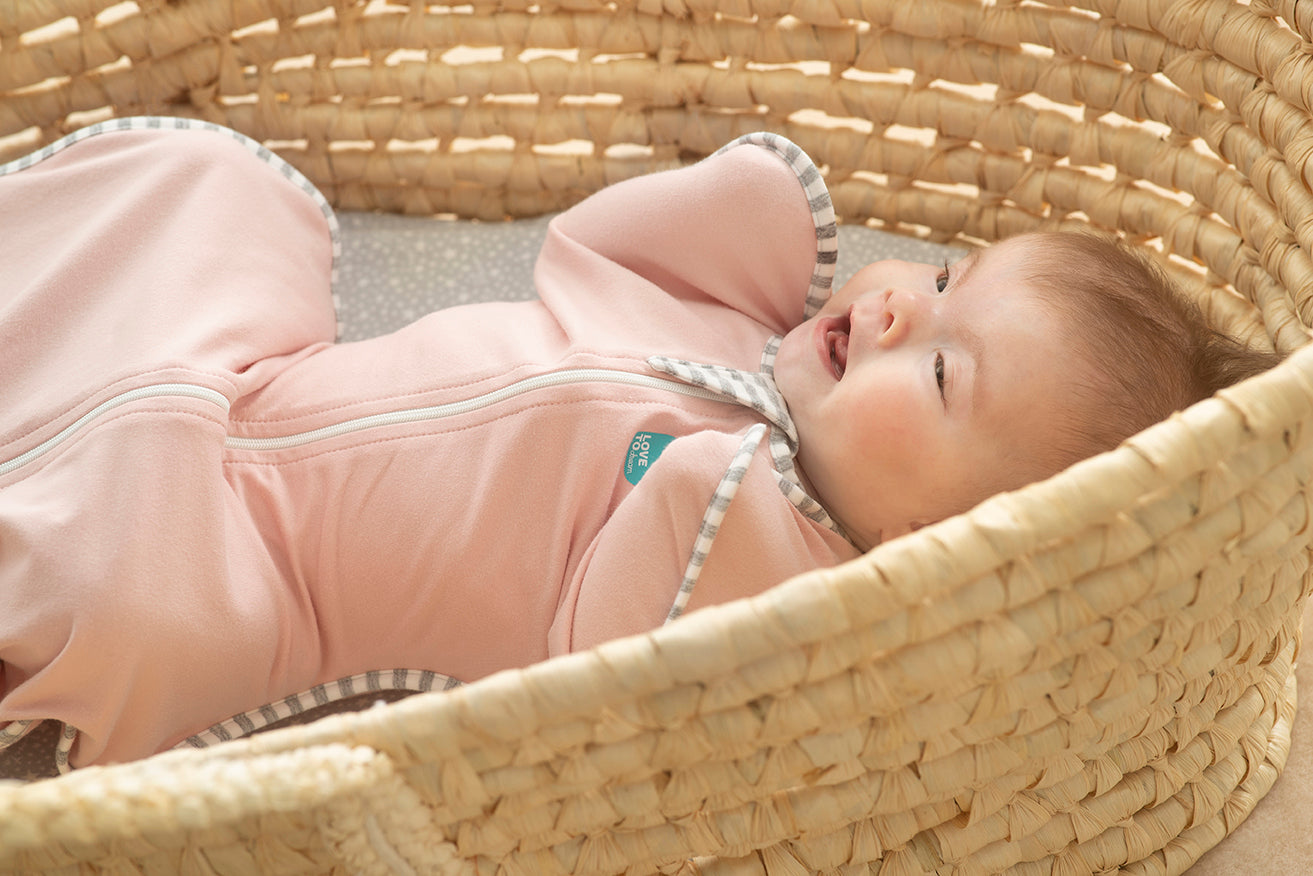What is a bassinet?
A bassinet is designed to enable your baby to sleep beside you for the first few months of its life. They can be used from birth and are compact, lightweight, and mobile. They can easily be moved from room to room and are usually placed beside your bed for monitoring throughout the night.
It’s up to your family whether you decide to use a bassinet or crib. Both are safe sleeping options when used correctly.
There are different types of bassinets to choose from:
- Freestanding bassinets with legs
- Portable bassinets
- Bassinets with wheels
- Side sleepers or co-sleeper bassinets
- Convertible bassinets
- Moses baskets
Do I need a bassinet?
Wondering if a bassinet is necessary? There are many reasons why parents choose to invest in a bassinet for their newborn. From safe sleep to monitoring your baby closely day and night, discover the reasons why we recommend a bassinet.
It’s convenient
For many first-time parents, having a baby is a daunting experience. A bassinet will enable you to keep an eye on your little one, no matter where you are in the house. Feeding and comforting your child is also a smoother process, especially if you are recovering from giving birth and/or breastfeeding.
It’s portable
Life is busy, especially for new parents. A bassinet is designed to give you flexibility at home and on the go. Whether you have friends over or are planning a weekend away, a bassinet means your baby will have a safe place to sleep no matter where you are.
It’s a great investment
Yes, bassinets can be expensive, but they’re made to last. As they’re only used for the first few months of your child’s life, they should remain in excellent condition. They can be handed down to other children or friends who are expecting - just make sure to change the mattress and sheets.
If cost is a factor in the decision-making process, you might want to consider a convertible bassinet. With the functionality of both a bassinet and cot, the bassinet extends into a full-sized cot once your baby is ready for the next step.
It can be customised to suit your lifestyle
Most bassinets come with add-on features. This might look like removable storage for nappies, clothing and other essentials, a hood that will shade your baby from the sunlight or a mosquito net.
It won’t take up much space
If you’re living in an apartment or have limited space, a bassinet is a better option than a crib. They’re small enough for use in the bedroom and can be moved around your home with ease.
The cosy element
Due to its compact size, a bassinet will also create a cosier sleep space that offers closeness and comfort for your little one.
Where should I put my bassinet?
It’s highly recommended that your child sleeps in the same room as you for the first six to 12 months, as this can reduce the risk of SIDS by up to 50%. The joy of a bassinet is that it’s portable, so your baby can safely sleep beside you both day and night.
Most parents choose to put the bassinet by their bed to keep a close eye on their little one. This is a safer alternative to co-sleeping and will enable you to feed and comfort your baby with ease.
How do I safely put my baby to sleep in a bassinet?
Bassinets are designed to be easy to move around the home. But this means they can be dangerous if not used correctly. Never move the bassinet with your baby inside it and if there are wheels, always lock them before settling your child down.
Make sure to follow the below steps when putting your baby to sleep in a bassinet:
- Ensure your baby’s mattress is firm, clean, and flat.
- Only buy sheets that are designed for the size of your baby’s bassinet. In winter, it is recommended that you securely tuck a blanket under your child’s mattress to reduce the risk of choking.
- Always ensure your baby is on their back before going to sleep. Never put your child to sleep on their side or tummy.
- Toys, loose objects or blankets can pose a choking hazard. Check there isn’t anything in your baby’s cot before putting them to sleep.
How long do babies sleep in a bassinet?
If you’re wondering when to move your baby from bassinet to crib, there are two signs to look out for.
- Your baby has reached the maximum height or weight limit of the bassinet.
- Your baby has started to show signs of rolling over or pulling up onto their hands. This usually occurs between four to six months but will differ between children.
Why won’t my baby sleep in a bassinet?
We have sung the bassinet’s praises, but you might find it’s still difficult to get your little one to drift off smoothly. We understand that every baby is different. To find what works for you, try our top tips from the Love To Dream™ experts.
- Some babies might not be able to fall asleep unless they're in your arms. To establish a healthy sleep routine, try putting your little one in the bassinet whilst they’re tired but still awake. This gives them more of an opportunity to learn to fall asleep without being rocked or cradled by you.
- Common sleep cues from newborns to look out for include rubbing their eyes, crying, yawning, clenching their fists and fussing.
- Try swaddling your baby to help them settle down. Our award-winning Swaddle UP™ is mindfully designed to give your child comfort and warmth by keeping their arms in a more natural upward position.
The Love To Dream Swaddle Up™ allows your baby to self-soothe and can be used for newborns and children up to 12 months. Crafted from soft and natural cotton, they’re available in different temperature ratings to ensure comfort all year round.
Once your baby starts to show signs of rolling over, our Love To Dream™ Transition Bags and Suits are the perfect next step - just ensure they are moved into a crib.
- Just like their parents, babies need to avoid overstimulation before bedtime. Try to reduce the amount of light in the room an hour before sleep. Overtired children are less likely to drift off easily so establishing a good nap routine throughout the day will help them to sleep well in the evening too.
- This leads us to a good night time routine. If you have time, carving out an hour before bed to settle your little one will help your baby to sleep more soundly. This might look like a bath, baby massage, reading a book or singing a lullaby. Find what works for you and your family.
How do I get my baby to sleep in a bassinet?
We know bedtime can be difficult for a lot of families. From our bestselling swaddles to moving the bassinet away from your bed, give our recommendations a go to see if your baby’s sleep improves.
- The timing of sleep is important. Most newborns sleep for approximately 12 to 16 hours over a 24-hour period. Putting your baby to sleep in their bassinet during daytime naps will help to settle them with ease. The goal is for your child to recognise the bassinet as a safe space to sleep.
- With a hip-healthy design that allows natural flexion of the legs and wings to enable a comfortable ARMS UP™ position, our Swaddle UP™ is designed to keep your baby comfortable in a bassinet.
- Try moving the bassinet one or two feet away from your bed. Although we know it’s comforting to check on your little one, giving each other a little space could be beneficial for the both of you.











